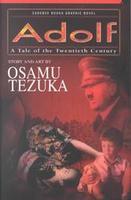1986 Kodansha Manga Award Winner
 Osamu Tezuka's manga series Adorufu ni Tsugu was my introduction to Japanese comics. Initially published in English by Viz Media in five volumes under the title Adolf between 1996 and 1997, the series is now available from Vertical in two hardcover omnibuses under the title Message to Adolf. The second omnibus, Message to Adolf, Part 2, was published in 2012 and collects chapters eighteen through thirty-six of the manga. In Japan Adorufu ni Tsugu was first serialized between 1983 and 1985. Tezuka went on to win the Kodansha Manga Award for the series in 1986. I am absolutely thrilled that after being out of print for so long the series is once again available in English. I was also happy to discover after reading Message to Adolf, Part 1 that the series was just as good if not better than I remembered it being. I looked forward to re-reading its conclusion a great deal.
Osamu Tezuka's manga series Adorufu ni Tsugu was my introduction to Japanese comics. Initially published in English by Viz Media in five volumes under the title Adolf between 1996 and 1997, the series is now available from Vertical in two hardcover omnibuses under the title Message to Adolf. The second omnibus, Message to Adolf, Part 2, was published in 2012 and collects chapters eighteen through thirty-six of the manga. In Japan Adorufu ni Tsugu was first serialized between 1983 and 1985. Tezuka went on to win the Kodansha Manga Award for the series in 1986. I am absolutely thrilled that after being out of print for so long the series is once again available in English. I was also happy to discover after reading Message to Adolf, Part 1 that the series was just as good if not better than I remembered it being. I looked forward to re-reading its conclusion a great deal.Forced to join the Hitler Youth and forced to kill, Adolf Kaufmann is no longer the innocent boy he once was. Despite being half-Japanese, he has quickly climbed the ranks of the Nazi elite, even becoming the personal secretary of Adolf Hitler for a time. Although his indoctrination is nearly complete, he is still plagued by guilt over the deaths he has caused. Back in Japan his best friend Adolf Kamil, a Jew, has come into possession of documents proving Hitler's Jewish heritage. Guarding the information with his life, the time has come to try to find a way to reveal the secret to the world in an attempt to take the Nazi party down. Those documents will bring Adolf Kamil and Adolf Kaufmann together once again, along with the Japanese journalist Sohei Toge.
One of the things that makes Message to Adolf work so well is that Tezuka expertly combines his historical fiction with historical fact. Placing his story within the context of the Second Sino-Japanese War and World War II (and eventually the Israeli-Palestinian conflict as well) emphasizes the realism of the tale. Tezuka's message in Message to Adolf is not a subtle one: the manga is inherently anti-war and anti-prejudice. A major theme is that war, hate, and extreme ideology are not only destructive but ultimately pointless. This is poignantly captured in the development of the character of Adolf Kaufmann who loses everything--his friends, his family, and even himself--as he strives to achieve the ideal that he has been taught is right. His downfall and undoing and the atrocities he and others commit in the name of justice and patriotism are as tragic as they are harrowing.
Message to Adolf is an impressively complex and layered narrative with several storylines that weave in and out of one another, sometimes overlapping and sometimes standing alone. Plot threads and characters introduced early on in the series return again in the second half, often in unexpected ways. Events that at first appear tangential are later pulled back into the main narrative. But as complicated as the structure of Message to Adolf is, Tezuka is in complete control the entire time. It is easy to follow and easy to be swept up in the epic tale. Message to Adolf is understandably bleak; it does deal with a dark period in history after all. Moments of light appear only to be repeatedly crushed. But ultimately, Message to Adolf leaves a hope that human beings can change and can do better. It's not free of problems, but I honestly believe Message to Adolf is one of Tezuka's best and most compelling series.








